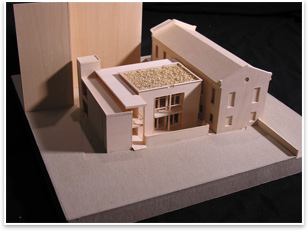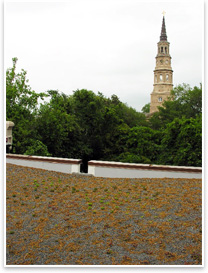| Greening God’s House
by Michael J. Crosbie, PhD, AIA
Contributing Editor
 Summary: It is hard to imagine a client better suited for green design services than a religious group. After all, some religious congregations have been taking care of their buildings for hundreds of years. They tend to be comfortable with the long view when making choices related to building performance, energy conservation, and sustainability. Some of these choices might mean that there is a higher initial cost, but over the long term the payback can be significant, especially when one considers that the choices one makes as a congregation will continue to reap benefits for future generations of congregants. Compared to clients for commercial buildings or residences, clients for religious structures are more likely to welcome information about the multiple benefits of green design. Summary: It is hard to imagine a client better suited for green design services than a religious group. After all, some religious congregations have been taking care of their buildings for hundreds of years. They tend to be comfortable with the long view when making choices related to building performance, energy conservation, and sustainability. Some of these choices might mean that there is a higher initial cost, but over the long term the payback can be significant, especially when one considers that the choices one makes as a congregation will continue to reap benefits for future generations of congregants. Compared to clients for commercial buildings or residences, clients for religious structures are more likely to welcome information about the multiple benefits of green design.
 This dynamic was abundantly clear at a conference last month in Charlotte, N.C., sponsored by the Duke Endowment’s Rural Church Division, which works with small Methodist parishes all over the state. Along with other forms of support, Duke’s Rural Church Division supports small parishes by making grants to pay for design services for church facilities. Over the past few years, the Rural Church Division has been emphasizing the importance of sustainability for new and rehab church construction projects. The whole point of the recent conference, according to the Rural Church Division’s Robb Webb, who helped organize it, was to “bring together church pastors and laity, architects, builders, and environmentalists for education and reflection on ways to implement environmentally friendly building design in rural North Carolina churches.” Over the course of two days, participants explored green building design and how it can be used to meet both the spiritual needs of a congregation and its economic realities. Invited to the conference to deliver the keynote address, it became clear to me that the economic benefits of green design and construction were only part of the story. This dynamic was abundantly clear at a conference last month in Charlotte, N.C., sponsored by the Duke Endowment’s Rural Church Division, which works with small Methodist parishes all over the state. Along with other forms of support, Duke’s Rural Church Division supports small parishes by making grants to pay for design services for church facilities. Over the past few years, the Rural Church Division has been emphasizing the importance of sustainability for new and rehab church construction projects. The whole point of the recent conference, according to the Rural Church Division’s Robb Webb, who helped organize it, was to “bring together church pastors and laity, architects, builders, and environmentalists for education and reflection on ways to implement environmentally friendly building design in rural North Carolina churches.” Over the course of two days, participants explored green building design and how it can be used to meet both the spiritual needs of a congregation and its economic realities. Invited to the conference to deliver the keynote address, it became clear to me that the economic benefits of green design and construction were only part of the story.
 Keep it simple Keep it simple
Along with presentations and workshops on how to cut physical plant operating costs, conserve energy, reduce equipment outlay, and generally improve building performance, there was a lot of discussion about how to talk about this subject to congregations. For many congregants, such as those serving on building committees, the technical aspects of such technologies as photovoltaic panels and ground-source heat-pumps can be intimidating. The message at the conference was that sustainable approaches for religious buildings needn’t be overly complex. Often the simplest things can have the greatest impacts, such as making sure a new building or addition is properly oriented to the sun, sufficient insulation is used, or high-performance windows are specified (and properly installed!). One strategy discussed was to take action right away, as soon as the conference attendees returned to their parishes. For example, changing all the incandescent light bulbs to compact fluorescents in a religious facility can easily be accomplished over a weekend by a congregation’s youth group.
Stress stewardship
For most religious congregations, stewardship is a key part of their mission. A congregation passes along to future generations not only a body of belief, but the buildings in which the congregation gathers to share and celebrate that belief. We find the ideals of conservation, social justice, equity, and balance in many systems of belief around the world. These ideals mesh seamlessly with the goals of sustainability: not only to lessen our impact on the earth, but also not to burden future generations with poor environmental choices. This is why religious clients are more and more receptive to sustainable design ideas. Architects can make good economic arguments for sustainable choices, knowing that congregations will benefit over the long history of their stewardship. But when discussing green design, don’t forget that religious clients will also respond to the ways that sustainability can support larger ideas, such as mission and social justice.
|




